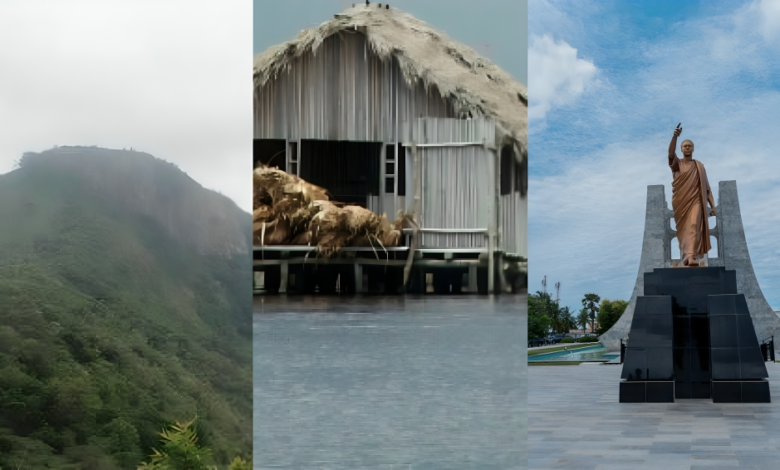7 of Ghana’s 16 regions that offer travellers the best tourism experience

Imagine waking up to the roar of waterfalls, walking through centuries of history, and dancing to the rhythm of vibrant festivals.
Ghana isn’t just a destination—it’s an experience that lingers in your soul long after you’ve left.
From the golden beaches of the Central Region to the wild savannas of the North, this West African gem packs endless adventure into every corner.
Whether you’re a culture seeker, nature lover, or history buff, Ghana’s diverse regions offer something extraordinary at every turn.
Asamoah Gyan praises GFA President Kurt Okraku for his efforts to ensure Ghana’s qualification for the 2026 World Cup following the AFCON disappointment. All he had to say…
Okatakyie Afrifa Mensah, host of For the Records podcast and former Angel FM presenter, was allegedly arrested near Kingsby Hotel in Achimota, sparking condemnation from NPP leaders who describe the move as a threat to press freedom and democracy.
Ready to explore? Here are 7 must-visit regions that showcase the very best of Ghana, where every journey feels like coming home.
Which one will you visit first?
Central Region
The Central Region is a must-visit for those drawn to history and coastal beauty.
Home to UNESCO World Heritage Sites like Cape Coast Castle and Elmina Castle, this region provides a profound connection to Ghana’s past, particularly the transatlantic slave trade.
Beyond its historical significance, the Central Region offers stunning beaches such as Brenu Akyinim and unique natural attractions like the Kakum National Park, where visitors can walk among the treetops on a thrilling canopy walkway.
The dry season, from November to April, is the ideal time to explore this region comfortably.
Ashanti Region
For travellers seeking a deep dive into Ghana’s cultural heritage, the Ashanti Region is unparalleled.
As the heartland of the Ashanti Kingdom, this region is rich in traditions, craftsmanship, and royal history.
Key attractions include the Manhyia Palace Museum, the residence of the Asantehene (Ashanti King), and Lake Bosomtwe, Ghana’s only natural lake.
The region is also famous for its Kente weaving villages, such as Bonwire, where visitors can witness the intricate process of creating this iconic fabric.
Timing a visit to coincide with the Akwasidae Festival offers a chance to experience vibrant celebrations of Ashanti culture, complete with drumming, dancing, and royal regalia.
Volta Region
Nature lovers will find paradise in the Volta Region, known for its lush landscapes and dramatic waterfalls.
The Wli Waterfalls, the tallest in West Africa, is a highlight, set within a pristine forest reserve.
Adventurous travellers can hike Mount Afadja, Ghana’s highest peak, or visit the Tafi Atome Monkey Sanctuary, where sacred monkeys roam freely.
The region’s serene beauty makes it perfect for eco-tourism, and visitors are encouraged to bring sturdy hiking shoes and swimwear to fully enjoy the natural wonders.
Greater Accra
Ghana’s capital, Greater Accra, blends urban energy with coastal charm.
This region is a hub of history, nightlife, and beachside relaxation.
Key sites include the Kwame Nkrumah Mausoleum, Independence Square, and Osu Castle, each offering insights into Ghana’s colonial and post-independence history.
Labadi Beach is a favourite for its lively atmosphere, especially on weekends, while Makola Market provides an authentic taste of local commerce and culture.
Greater Accra is ideal for travellers who want a mix of city exploration and beachside leisure.
Western Region
The Western Region is a hidden gem for eco-tourism and secluded beaches.
The Nzulezu Stilt Village, built entirely on water, is a unique cultural attraction, while Busua and Butre Beaches offer pristine sands and excellent surfing conditions.
Nature enthusiasts can explore the Ankasa Conservation Area, a biodiverse rainforest, or visit Fort Metal Cross for a glimpse into the region’s colonial past.
A boat tour of Nzulezu is a must for an unforgettable experience of this extraordinary village.
Northern Region
Wildlife and cultural heritage take centre stage in the Northern Region, home to Mole National Park, Ghana’s premier safari destination.
Here, visitors can spot elephants, antelopes, and baboons in their natural habitat.
The Larabanga Mosque, one of West Africa’s oldest, showcases stunning Sudanese-Sahelian architecture, while the Mognori Eco-Village offers a glimpse into traditional northern Ghanaian life.
The dry season, from December to April, is the best time for wildlife viewing in Mole National Park.
Eastern Region
Finally, the Eastern Region is a haven for hikers and adventure seekers.
Boti Falls, with its twin cascades and mystical umbrella rock, is a standout attraction, along with the peaceful Aburi Botanical Gardens.
The Bunso Arboretum features a canopy walkway, providing a treetop perspective of the region’s lush forests.
Visiting Boti Falls during the rainy season (May to October) ensures the most impressive waterfall views.





